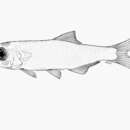Diagnostic Description
(
Inglês
)
fornecido por Fishbase
Diagnosis: Small and slender or moderately deep-bodied fishes, its depth 20-28% of standard length, perhaps not reaching much over 2 cm standard length; belly rounded, pre-pelvic scutes 4-7, with lateral arms, but without keels; pelvic scute with 2 or 3 lateral arms; post-pelvic scutes 3-5, keeled and with arms; posterior supra-maxilla absent; lower gillrakers 10-12; pelvic insertion well before dorsal fin, with 1 unbranched and 6-7 branched finrays; anal fin beginning under dorsal fin base (Ref. 188, 81631, 93833). The presence of scutes distinguishes Thrattidion noctivagus from Congothrissa gossei and the absence of a posterior supra-maxilla distinguishes it from all other West or Central African pellonulines (Ref. 188).Description: Small and slender or moderately deep-bodied fishes, body relatively compressed, its depth 20-28% of standard length (Ref. 188, 104594). Snout short and rounded; jaws equal; eye large, its center on or slightly above longitudinal midline of body; adipose eyelid well developed (Ref. 104594). Premaxillary with 4-7 small conical teeth solidly implanted, and 2-4 replacement teeth in the gum; maxillary edentulous; dentary with a dozen to 15 small conical teeth solidly implanted and several teeth in stages of replacement; palatine with one to three teeth, roof of mouth otherwise edentulous; fifth ceratobranchial and upper pharyngeal with numerous small teeth, gill arches otherwise edentulous (Ref. 104594). There are 10-12 gillrakers along the lower limb of the first gill arch; upper limb with 4 short, widely spaced gillrakers (Ref. 188, 81631, 93833, 104594). Posterior supra-maxilla absent (Ref. 28136, 81631). Dorsal fin with 14-16 rays, first three or four simple, last divided to base, its origin a little behind pelvic fin insertion, slightly closer to end of caudal fin than to snout tip; anal fin with 23-25 rays, first four or five simple, last divided to base, long, its origin on a vertical through base of eighth or ninth dorsal fin ray; pectoral fin with usually 10 rays; pelvic fin with 1 unbranched and 6-7 branched rays, relatively large, only slightly smaller than pectoral, its origin closer to pectoral fin origin than to anal fin origin; dorsal and anal fin margins gently falcate, dorsal height about 1.5 times anal height; caudal fin deeply forked, upper and lower caudal lobes identical in size and shape; principal caudal rays invariably 10+9, upper procurrent rays 12-13 and lower procurrent rays 8-10 (Ref. 81631, 104594). Scales largely absent, restricted to a double row of 4-9 scales superficial to lateral arms on each side of pre-pelvic scutes, a single row of 4-5 scales superficial to lateral arms on either side of post-pelvic scutes, and about a dozen scales in four or five short rows immediately behind head; the latter scales are deeply embedded in tough tissue in which the trunk portion of the cephalic laterosensory system ramifies, and can only be fully discerned in cleared and stained specimens; most of the scales in the longest row are perforated by laterosensory canals (Ref. 104594). There are 4-7 pre-pelvic scutes, unkeeled, with well-developed lateral arms; pelvic scute keel-less, with bifurcate or trifurcate lateral arms in largest specimens; 3-5 post-pelvic scutes, with well-developed keels and lateral arms (Ref. 81631, 104594). Vertebrae 45-47, about equally divided between abdominal and caudal vertebrae (Ref. 104594).Colouration: Preserved specimens are opaque whitish, lacking melanophores or with a few at the anal fin base and on the caudal peduncle; no lineum argenteum; a dense cluster of large melanophores over brain (Ref. 81631, 104594). Peritoneum probably opaque white and body otherwise translucent in living specimens (Ref. 104594).
- licença
- cc-by-nc
- direitos autorais
- FishBase
- Recorder
- Crispina B. Binohlan
Morphology
(
Inglês
)
fornecido por Fishbase
Dorsal spines (total): 0; Dorsal soft rays (total): 14 - 16; Analspines: 0; Analsoft rays: 23 - 25; Vertebrae: 45 - 47
- licença
- cc-by-nc
- direitos autorais
- FishBase
- Recorder
- Crispina B. Binohlan
Trophic Strategy
(
Inglês
)
fornecido por Fishbase
A riverine species, collected only at dusk and dawn in swiftly flowing water of about 1 m just above the hydro-electric dam at Edea, Cameroon (Ref. 188). It feeds on plankton and some terrestrial insects (Ref. 188).
- licença
- cc-by-nc
- direitos autorais
- FishBase
- Recorder
- Crispina B. Binohlan
Biology
(
Inglês
)
fornecido por Fishbase
A riverine species, collected only at dusk and dawn in swiftly flowing water of about 1 m just above the hydro-electric dam at Edea, Cameroon (Ref. 188). It feeds on plankton and some terrestrial insects (Ref. 188).
- licença
- cc-by-nc
- direitos autorais
- FishBase
- Recorder
- Crispina B. Binohlan
Importance
(
Inglês
)
fornecido por Fishbase
fisheries: of no interest
- licença
- cc-by-nc
- direitos autorais
- FishBase
- Recorder
- Crispina B. Binohlan
Sanaga pygmy herring
(
Inglês
)
fornecido por wikipedia EN
The Sanaga pygmy herring (Thrattidion noctivagus) is an extremely small fish related to the herring which is endemic to the Sanaga River in Cameroon. It is the only species in its genus.
References

- licença
- cc-by-sa-3.0
- direitos autorais
- Wikipedia authors and editors
Sanaga pygmy herring: Brief Summary
(
Inglês
)
fornecido por wikipedia EN
The Sanaga pygmy herring (Thrattidion noctivagus) is an extremely small fish related to the herring which is endemic to the Sanaga River in Cameroon. It is the only species in its genus.
- licença
- cc-by-sa-3.0
- direitos autorais
- Wikipedia authors and editors

